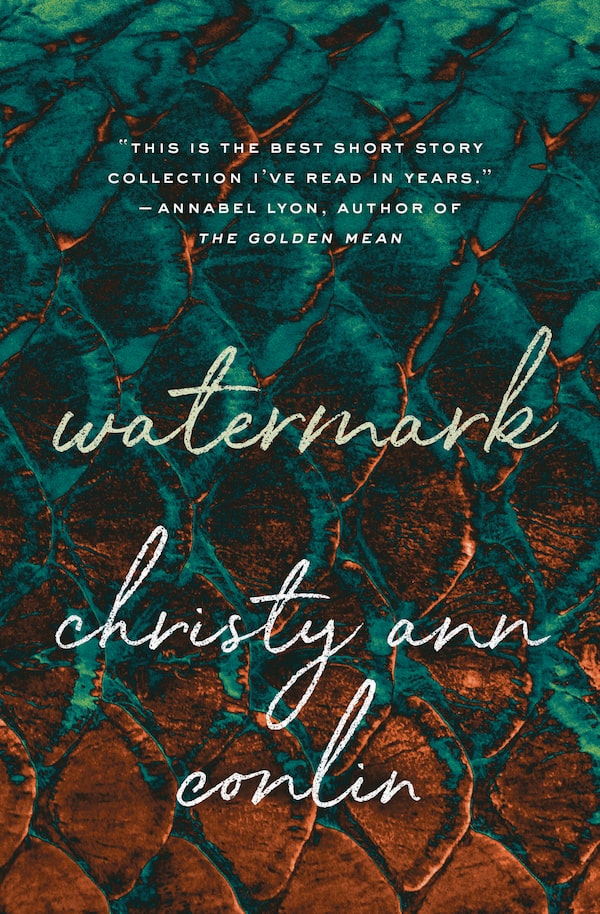
In Watermark, Christy Ann Conlin, pictured, returns to the landscape of her 2002 debut novel Heave and 2016’s The Memento: the Bay of Fundy and the Mountain.Kate Inglis/Handout
- Title: Watermark
- Author: Christy Ann Conlin
- Genre: Fiction
- Publisher: Astoria
- Pages: 300
A sometimes-mystical Gothic in which the horror arises from those closest to us, Christy Ann Conlin’s new story collection has me thinking about everyday tyrants and whether we can ever truly erase their mark.
In Watermark, Conlin returns to the landscape of her 2002 debut novel Heave and 2016’s The Memento: the Bay of Fundy and “the Mountain” (properly, North and South Mountain, the parallel volcanic ridges that cradle Nova Scotia’s Annapolis Valley). Many of Conlin’s characters try to escape this locale: to Vancouver, Frankfurt, Saigon, Zurich and Churchill, Man. They’ve made a break for it only to find the bullies from their past still haunt them.
Often we speak of being treated unjustly through the metaphor of scarring. Conlin’s image of the watermark – subtle yet virtually indelible – seems more apt to describe how we carry the experience from marred past relationships into our present ones. In the story Occlusion, Conlin writes, “It was the summer grief pressed in upon me in the way a watermark imprints paper, permanent and imperceptible in certain light.”
These stories are about how hurt changes a person in ways obscure to those around them. In Full Bleed, a character wonders “why his wife might have lied about where exactly she took the old ladies every year,” realizing too late she wanted to protect him from the turned screw of her family elders’ manipulation. Meanwhile, in Back Fat, a self-involved husband makes all sorts of assumptions about his wife’s past, oblivious to how a letter from back home represents a ticking time bomb of guilt.
I’m hesitant to group this pain under the levelling term “trauma.” Murder, negligence causing death, the sexual assault of a minor – these events in Conlin’s book are prosecutable crimes in Canada, but Watermark’s focus lies a slight shift away from such obvious wrongs.
“My wife’s grandmother uses crying to get what she wants.”
“My friend from high school was always cutting me down. ‘You’ve got back fat,’ she would say. ‘And saggy tits.’ A decade later she still contacts me, expecting me to do things for her.”
“My father, who I haven’t spoken to in 30 years, e-mails me out of the blue like he isn’t responsible for what happened to our family. He expects me to drop everything to meet with him.”

Watermark by Christy Ann Conlin.Handout
These are not crimes but the unresolved emotional tangles that keep a person up at night. Two other books from recent years inform my reading of the particular psychology of Watermark’s stories. The first of these books is Stephen Greenblatt’s Tyrant, about Shakespeare’s autocrats and the pathological narcissism that shapes not only their deadly political manoeuvrings, but also who they are as husbands and fathers. (Think of Lear lashing out at his daughter Cordelia because she refuses to ape her sisters’ empty fawning.) The tyrant is essentially a bad dad with more room to work.
The second book, Sarah Schulman’s Conflict Is Not Abuse, arrives at similar conclusions, although Schulman primarily addresses this will to exert “power over” others at the level of the personal relationship. One memorable passage describes a person who “acts as though others should follow his order, and when they refuse he punishes, bullies, shuns, makes false accusations, organizes group exclusion, distorts narratives, and may threaten and use the law or even violence.” Schulman’s point is that we all know this person who behaves like a tyrant. They are our lover, child, parent, sibling, co-worker or friend.
Both Greenblatt and Schulman detail a form of epistemological closure: the mad king and the family bully refuse or misinterpret new information that contradicts their sense of victimhood, that they have been wronged and that this wrong is continuous. It’s this warped thinking that, Schulman says, can make the traumatized blind to their own abusive behaviour. Tyrant and Conflict Is Not Abuse are eye-opening works of non-fiction, but fiction is an art that can give a reader – who possibly knows emotional abuse personally – a new window onto the topic through point of view.
The first two stories in Watermark are disorienting in how close they bring us to their protagonists’ internalized rage and desire for control. “It was happening more and more, these surges of anger choking off her breath whenever she talked to her daughter. There was something beneath the anger, something quiet and desperate, poking at her insides,” Conlin writes in Eyeball in Your Throat. “Lucy hated thinking about how hard she had to work to crush Deirdre back into place.” In Dead Time, the narrator’s misinterpretation of events and self-justifying evasions lead to extreme violence.
In Back Fat, two people from “back home” meet in Churchill. One is from North Mountain; the other, from the eastern part of the Valley floor, tells a Prairie-raised doctor “not everyone from the East Coast knew each other.” This is a joke, because the speaker is Deirdre, the subject of the collection’s opening story, whose name Conlin’s readers will recognize from Heave. (A reconfigured version of Heave’s opening also appears as the story Beyond All Things Is the Sea.) In Watermark everyone might not know each other, but they aren’t far removed: The Flying Squirrel Sermon gives a different perspective to Dead Time; The Diplomat and Back Fat meet in Saigon; Full Bleed, Occlusion and Beyond All Things is the Sea share a tangential character at different stages of her life.
Is there a purpose to these connections, beyond the small aesthetic pleasure they bring? In her debut novel, Conlin’s narrator mentions how outsiders know the Mountain as the setting of the real-life Goler clan incest scandal of the 1980s. “We here in the Valley would like to pretend that it never happened at all,” Conlin writes – an understandable impulse if an ironic one, since it was exactly this distancing and social isolation that allowed the incest to happen for generations. Conlin has matured as a writer since her first book. Watermark is taut, sharp writing that as a whole has greater psychological depth than her previous work. Conlin doesn’t pass judgment on her characters, but she doesn’t let them off the hook either. It turns out there are far more petty tyrants here than the Valley would like to recognize.
Expand your mind and build your reading list with the Books newsletter. Sign up today.